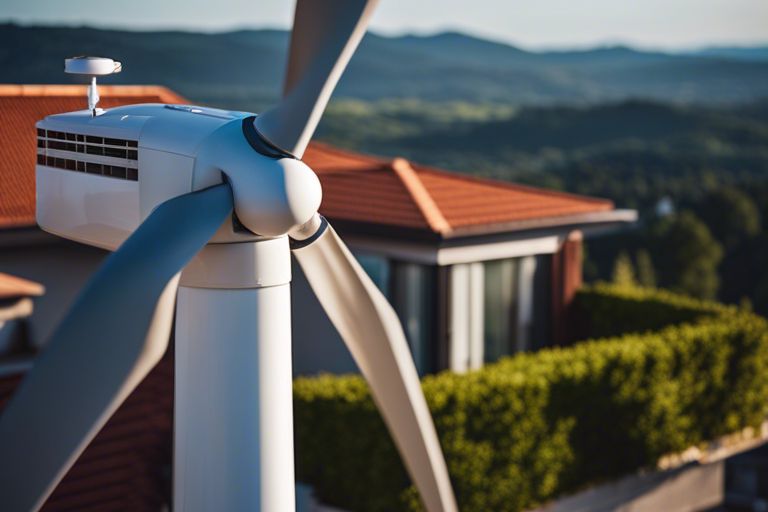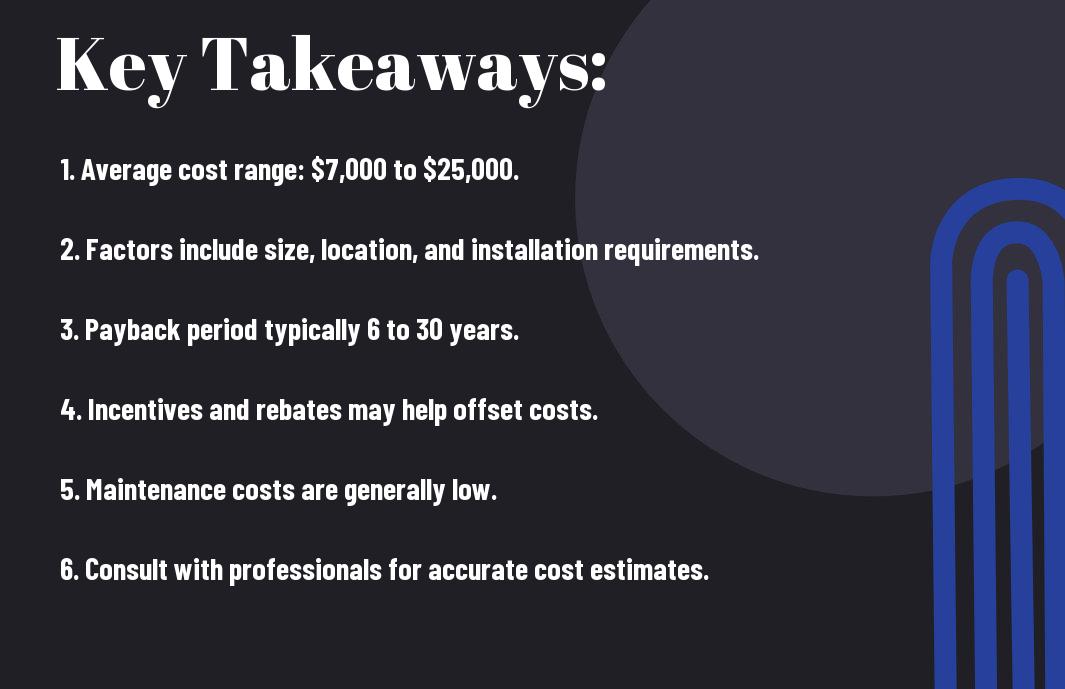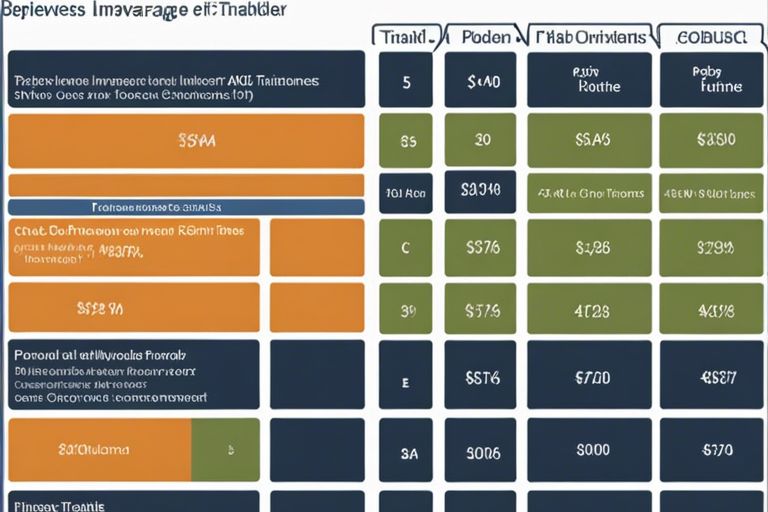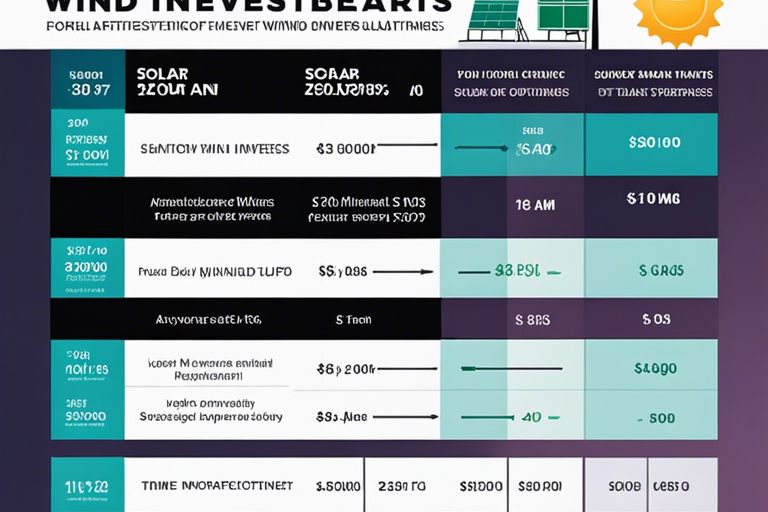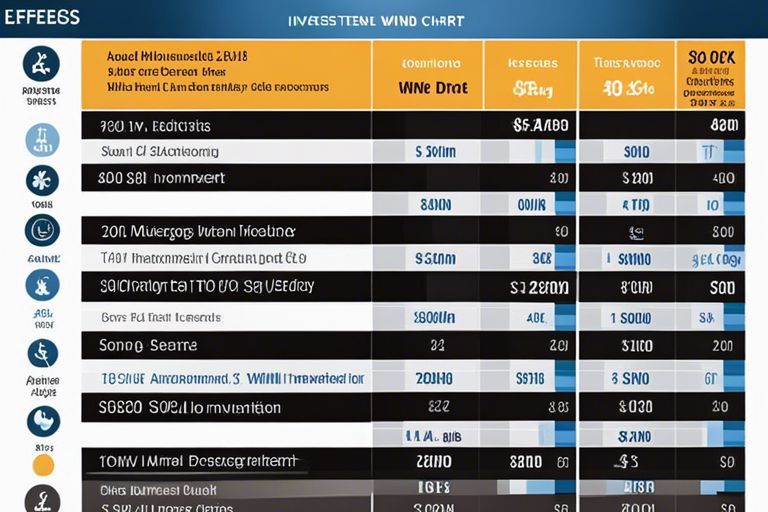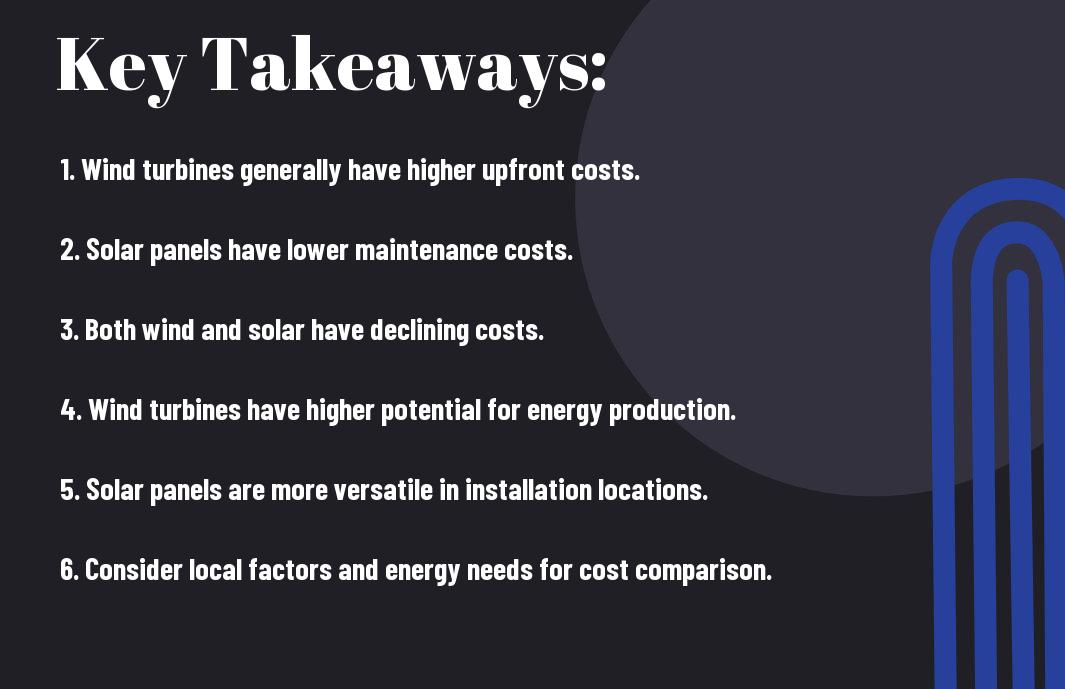Household wind turbines can be a great way to harness renewable energy and reduce your carbon footprint while also potentially saving money on your electric bill. When considering the cost of a wind turbine for your home, factors such as the size of the turbine, installation expenses, and potential rebates or incentives should all be taken into account. According to How Much Do Wind Turbines Cost? (2024), the price can vary widely, but it’s important to weigh the long-term benefits for both your wallet and the environment.
Key Takeaways:
- Initial Investment: The cost of a residential wind turbine can range from $15,000 to $70,000, depending on the size and capacity of the turbine.
- Additional Costs: Installation, permits, and possible maintenance expenses should also be factored into the overall cost of a wind turbine for a house.
- Return on Investment: Over time, the savings on electricity bills can offset the initial investment, making residential wind turbines a cost-effective energy solution in the long run.
- Government Incentives: Some regions offer tax credits, rebates, or incentives for installing renewable energy sources like wind turbines, which can help reduce the upfront cost.
- Professional Consultation: It is advisable to consult with a professional to assess the feasibility of installing a wind turbine on your property and to get accurate cost estimates tailored to your specific situation.
Factors Affecting Wind Turbine Cost
The cost of a wind turbine for your house can vary based on several key factors. Understanding these factors can help you make an informed decision about the investment you are about to make.
Location and Zoning Regulations
Location plays a crucial role in determining the cost of a wind turbine for your house. Factors such as wind speed, topography, and proximity to power lines can all impact the overall cost. Additionally, zoning regulations in your area may dictate the size and height of the turbine you can install, which can also affect the cost.
After considering these factors, you may need to make adjustments to your initial budget to account for any additional requirements or restrictions that your location imposes.
Turbine Size and Capacity
One of the main factors that will influence the cost of a wind turbine for your house is the size and capacity of the turbine you choose. Larger turbines with higher capacity generally cost more upfront but may be more cost-effective in the long run, as they can generate more electricity.
Installation and Maintenance Costs
Costs associated with the installation and maintenance of a wind turbine can also impact the overall cost. Installation costs can vary depending on factors such as site preparation, permits, and labor. Additionally, ongoing maintenance costs, such as regular inspections and repairs, should be factored into your budget.
Types of Wind Turbines for Residential Use
Assuming you are considering installing a wind turbine for your house, it’s crucial to understand the different types available to make an informed decision. Residential wind turbines generally fall into three categories: Horizontal Axis Wind Turbines, Vertical Axis Wind Turbines, and Roof-Mounted Turbines.
Horizontal Axis Wind Turbines
On the one hand, Horizontal Axis Wind Turbines (HAWTs) are the most common type used for residential applications. These turbines have blades that rotate around a horizontal axis, resembling a traditional propeller. HAWTs are usually mounted on a tower to capture the higher wind speeds available at greater heights. This design allows for efficient electricity generation in a wide range of wind conditions.
Vertical Axis Wind Turbines
With Vertical Axis Wind Turbines (VAWTs), the blades rotate around a vertical axis, making them ideal for areas with changing wind directions or turbulent wind. VAWTs are often more compact and can be mounted closer to the ground, making them suitable for residential settings where space is limited. This design also simplifies maintenance as all the mechanical components are located at the base of the turbine.
Horizontal Axis Wind Turbines have been around for a long time and are more commonly seen in commercial wind farms but can also be suitable for residential use, especially in areas with consistent wind patterns.
Roof-Mounted Turbines
With Roof-Mounted Turbines, you can harness the power of the wind right from your rooftop. These compact turbines are designed to be installed on top of buildings, making them a convenient option for urban or suburban homes. While they may not generate as much electricity as larger turbines, roof-mounted options can still supplement your energy needs and reduce your reliance on the grid.
Wind energy is a sustainable and renewable resource that can help you lower your carbon footprint and save on electricity costs. By choosing the right type of wind turbine for your residential needs, you can take a positive step towards a greener future for you and your family.
Average Cost of Wind Turbines for Houses
Now, let’s break down the average cost of wind turbines for houses based on the size of the turbine you might need. Small turbines (2-5 kW) are typically the most affordable option for residential homes. These turbines can cost anywhere from $8,000 to $15,000, including installation. While they may not generate as much power as larger turbines, they can still significantly reduce your electricity bills and carbon footprint.
Small Turbines (2-5 kW)
To maximize the efficiency of small turbines in residential settings, it’s crucial to ensure that your property has enough unobstructed space to harness the wind effectively. Additionally, you may need to obtain permits and comply with local regulations before installing a small wind turbine on your property.
Medium Turbines (5-10 kW)
An excellent option for larger households with higher energy demands, medium turbines (5-10 kW) come at a higher price point. These turbines typically range from $20,000 to $40,000, depending on the brand and installation costs. While the initial investment may be higher, medium turbines can produce more electricity, making them a cost-effective choice in the long run.
Another advantage of medium turbines is their ability to generate surplus electricity that can be sold back to the grid, providing you with potential cost savings or even additional income. Before installing a medium turbine, it’s crucial to assess your energy needs and consult with a professional to determine the right size for your property.
Large Turbines (10-20 kW)
To power larger homes or properties with significant energy requirements, large turbines (10-20 kW) are the ideal solution. These turbines can cost anywhere from $50,000 to $80,000, including installation costs. While the initial investment is substantial, large turbines can generate a considerable amount of electricity, potentially making you energy independent.
To ensure the optimal performance of a large wind turbine, regular maintenance and monitoring are crucial. It’s also crucial to consider factors such as the average wind speed in your area and any potential obstructions that could affect the turbine’s efficiency.
Incentives and Rebates for Residential Wind Turbines
Many incentives and rebates are available to help offset the cost of installing a wind turbine on your property. These incentives can come from federal, state, and local governments, as well as utility companies. Taking advantage of these programs can significantly reduce the overall cost of your wind turbine project.
Federal Tax Credits
Any residential wind turbine system installed before December 31, 2022, is eligible for a federal Investment Tax Credit (ITC) of 26% of the total project cost. This credit can be applied to your federal tax liability, reducing the amount you owe or increasing your tax refund. Make sure to check the current regulations and requirements to qualify for this credit.
State and Local Incentives
Any state or local incentives available for residential wind turbines will vary depending on where you live. Some states offer additional tax credits, rebates, or grants to homeowners who install renewable energy systems like wind turbines. These incentives can further reduce your out-of-pocket expenses and make investing in a wind turbine more financially feasible.
Credits from state and local incentives can significantly contribute to making your wind turbine project more cost-effective. By researching and leveraging these programs, you can maximize the financial benefits of generating clean energy on your property.
Utility Company Rebates
Rebates for residential wind turbines are sometimes offered by utility companies as part of their efforts to promote renewable energy generation. These rebates can come in the form of upfront discounts on the purchase and installation of a wind turbine, making it more affordable for you to go green with your energy sources.
Plus, some utility companies offer net metering programs, where you can sell excess electricity generated by your wind turbine back to the grid, further offsetting your energy costs and potentially providing you with additional savings.
Payback Period and Return on Investment
Once again, before making the decision to invest in a residential wind turbine, it’s important to consider the payback period and return on investment. Understanding these factors will give you a clear picture of when you can expect to start seeing a return on your initial investment.
Calculating Payback Period
Payback period refers to the amount of time it takes for the cost of the wind turbine to be recouped through energy savings. To calculate the payback period, divide the total cost of the turbine by the annual energy savings it provides. This will give you a rough estimate of how many years it will take to break even on your investment.
Factors Affecting ROI
- The wind speed in your area
- The cost of electricity
- The size and efficiency of the turbine
This will determine how quickly you see a return on your investment in a residential wind turbine.
Average ROI for Residential Wind Turbines
With an average return on investment of 5-10%, residential wind turbines can be a long-term investment in both energy savings and environmental impact.
To determine the specific ROI for your situation, consider factors such as the cost of installation, maintenance, and the amount of energy your turbine generates. By analyzing these factors, you can make a more informed decision about whether investing in a wind turbine is the right choice for your home.
Installation and Maintenance Considerations
Installation Costs and Timeline
Unlike solar panels, which can typically be installed on a roof, a wind turbine requires a specific location with sufficient wind exposure. This may involve additional costs for site preparation, such as installing a tall enough tower to catch the wind effectively. The installation process can take anywhere from a few days to a few weeks, depending on the size of the turbine and the complexity of the site.
Ongoing Maintenance and Repair
Maintenance of a residential wind turbine primarily involves regular inspections of the blades, tower, and electrical components to ensure everything is functioning correctly. You may need to clean the blades periodically to remove any debris that could affect performance. It’s also important to have a professional conduct annual maintenance to keep your turbine in optimal condition.
Maintenance and repair costs can vary depending on the size and type of the turbine you choose. It’s important to factor in these ongoing expenses when considering the overall cost of installing a wind turbine for your house.
Warranty and Support Options
When investing in a residential wind turbine, it’s crucial to inquire about the warranty and support options provided by the manufacturer. Some manufacturers offer extended warranties or service agreements that can provide you with peace of mind should any issues arise with your turbine. Be sure to ask about the availability of spare parts and technical support to ensure you can maintain your turbine properly over the years.
Understanding the warranty and support options available for your residential wind turbine can help you plan for any future maintenance or repairs that may be needed. It’s important to choose a reputable manufacturer that stands behind its products and offers reliable customer support to assist you throughout the lifespan of your turbine.
Final Words
So, in conclusion, investing in a wind turbine for your house can be a cost-effective and environmentally friendly way to generate electricity. While the initial cost may seem high, the long-term savings on your energy bills and the positive impact on the environment make it a worthwhile investment. Remember to consider factors such as location, size, and installation costs when determining the total cost of a wind turbine for your home. With careful planning and consideration, you can harness the power of the wind to help power your household for years to come.
FAQ
Q: How much does a wind turbine cost for a house?
A: The cost of a wind turbine for a house can vary depending on various factors such as the size and type of the turbine, installation expenses, location, and any additional features. On average, a small wind turbine suitable for residential use can cost between $10,000 to $70,000.
Q: What factors influence the cost of a wind turbine for a house?
A: The cost of a wind turbine for a house is influenced by factors such as the size and capacity of the turbine, installation costs, site preparation, permitting, grid connection, maintenance, and any additional features like battery storage systems or monitoring equipment.
Q: Are there any incentives or rebates available for installing a wind turbine for a house?
A: Yes, there are often incentives, rebates, and tax credits available for installing a wind turbine for a house. These incentives can vary depending on your location and the specific regulations in place. It is advisable to check with local government programs, utility companies, or renewable energy organizations to see what incentives may be available to help offset the cost of installing a wind turbine.

